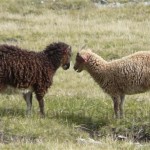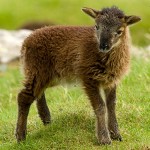In 2010, Scottish researchers revealed to the world that over the past 25 years, the size of the average Soay sheep on the island of St Kilda (Scotland) had been decreasing.
Indeed, while lambs used to weigh 13 pounds (15 kg) in average in 1986, they weighed 28.6 pounds (13 kg) twenty years later. Same for adults sheep who lost 6.6 pounds (3 kg) going from 55 pounds (25 kg) to 48.4 pounds (22 kg) over the same period of time. However, according to natural selection, sheep should have been getting bigger because a large size gives them a selective advantage: why are they getting smaller on the island of Saint Kilda?

The number of dark coat sheep has been decreasing in comparison to light coat sheep
Another fact adds up to the shrinking: the number of dark sheep is decreasing. And size is correlated to color: the studies reveal that black sheep are systematically bigger than light colored ones.
Those observations are established and there is no controversy about the fact that sheep are decreasing in size and getting lighter. The controversy rather lies in the reasons for this phenomenon, which differ among scientists. Today, the controversy of Soay sheep of St Kilda is divided into two major debates. On the one hand, scientists are trying to explain why sheep are changing color and on the other hand, they are looking for reasons for the decrease in size of the average sheep. Some argue climate change is the reason, other believe there is not enough evidence and other factors must be taken into account. The controversy is the following:
Does climate change cause Soay sheep to change size and color?
Soay sheep are one of the 38 to 85 animals and plant species that are believed to be shrinking all around the world today. Yet, their case is certainly unique, because both their way of life and location constitute one of the biggest outside laboratory in the world: no human lives on Saint Kilda, their meat, milk and wool are not exploited, the island is isolated and geographically limited. What’s more, the national charity “Rare Breeds Survival Trust” classified them in the “Category 4: at Risk” because the number of ewes is really small.
In this self-guided tour, just explore the website the way you want and look for the different information you need using the top and bottom menus. Ready?

